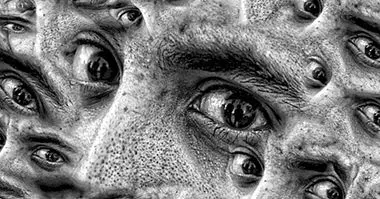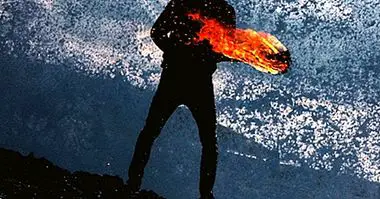Major depression: symptoms, causes and treatment
Throughout our lives, it is possible to feel sad for some reason or to have a bad streak in the emotional field. And even though nobody likes to go through these potholes, The truth is that suffering can even make you grow as a person , and, ultimately, be positive for your personal development.
However, it is necessary to be aware that, in some cases, what we might think is simple sadness or an emotional slump, is actually a depressive process; that is, pathological. There are different types of depression, and in this article we will talk about the most serious depressive disorder: major depression .
- Related text: "Are there several types of depression?"
Major depression: what is it?
Major depression is a mood disorder characterized by the appearance of one or more depressive episodes of minimum two weeks of duration, and presents a set of symptoms of affective predominance (pathological sadness, apathy, anhedonia, despair, decay, irritability, etc.). However, symptoms of cognitive, volitional and somatic type are also present during their course.
Thus, people who have major depression are not simply "sad", but tend to show an extreme lack of initiative to do anything, as well as an inability to be cheerful and feel pleasure, a phenomenon known as anhedonia. They also experience other physical and psychological problems that significantly damage their quality of life.
On the other hand, major depression also affects how you think and reason. In general, the total or partial lack of motivation makes people who have entered into a crisis of this type seem absent and do not feel like doing anything, not even think much (which does not mean they have mental disability).
The major depressive picture can be divided into mild, moderate or severe, and It usually has its beginning during adolescence or young adulthood . The individual suffering from this condition may experience phases of normal mood between depressive phases that may last for months or years.
On the other hand, major depression is a type of unipolar depression, that is, it does not present phases of mania (which differentiates it from bipolarity), and the patient can have very serious problems if he does not receive adequate treatment.
Frequent symptoms
According to the fifth edition of the Manual Statistical Diagnosis of Mental Disorders (DSM-V), for the diagnosis of major depression, the subject must have five (or more) of the following symptoms during the depressive period (at least two weeks) .
These must represent a change with respect to the patient's previous activity; and one of the symptoms must be (1) depressed mood or (2) loss of interest or ability to feel pleasure.
- Depressive mood most of the day , almost every day (1)
- Loss of interest in activities that were rewarding before (2)
- Loss or gain of weight
- Insomnia or hypersomnia
- Low self-esteem
- Problems of concentration and problems to make decisions
- Feelings of guilt
- Suicidal thoughts
- Agitation or psychomotor retardation almost every day
- Fatigue or loss of energy almost every day
Types of major depression
In addition, the DSM-V specifies that symptoms must cause clinically significant distress or impairment in social, occupational or other important areas of functioning. The episode can not be attributed to the physiological effects of a substance or other medical condition, and the episode of major depression is not better explained by a schizoaffective disorder, schizophrenia, schizophreniform disorder, delusional disorder, or other specified or unspecified disorder of the disorder. spectrum of schizophrenia and other psychotic disorders.
There are two types of major depression:
- Major depression with single episode : there is only the presence of a single depressive event in the patient's life.
- Major recurrent depression : Depressive symptoms appear in two or more episodes in the patient's life. The separation between depressive episodes should be at least 2 months without presenting the symptoms
Causes of this mood disorder
Major depression is a multifactorial phenomenon , so that different factors could cause this psychopathology: genetic factors, experiences of childhood and current psychosocial adversities (social context and aspects of personality).
In addition, difficulties in social relationships, cognitive dysfunctions or socio-economic status could be risk factors for the development of this disorder. Probably, but, the interaction of biological, psychological and social factors favor the appearance of major depression.
As well major depression has been linked to a lack of dopamine in the reward system of the brain, which makes the person have no goals. This fact can be the trigger for a sedentary and monotonous lifestyle and the serious self-esteem problems that usually appear in these cases.

Treatment
Major depression is a serious pathology but, fortunately, treatable . Treatment options usually vary depending on the severity of the symptoms, and in severe cases, the administration of psychotropic drugs combined with psychotherapy seems to be the most appropriate treatment.
However, in recent years the effectiveness of other treatments has been shown, for example, that of Electroconvulsive Therapy (TEC) , which is usually used when depressive symptoms are severe or drug therapy does not work. Of course, this therapy is not comparable to the old electroshock, since the intensity of the discharges is much lower.
On the other hand, while Mindfulness has shown some effectiveness in intervening in cases of mild depression, with major depression does not seem to work.
However, people diagnosed with major depression they can fall easily in this type of crisis , so that the treatment is considered as a lifelong aid.
Treatment with psychotherapy
Psychological therapy has proven to be an effective tool for the treatment of depression , especially cognitive-behavioral therapy. This type of therapy considers the patient as a system that processes information from the environment before issuing a response. That is, the individual classifies, evaluates and gives meaning to the stimulus in terms of their set of experiences from the interaction with the environment and their beliefs, assumptions, attitudes, worldviews and self-assessments.
In cognitive behavioral therapy, different techniques are used that aim to have a positive effect on low self-esteem, negative problem-solving styles or the way of thinking and evaluating the events that occur around the patient. Here are some of the most common cognitive behavioral techniques:
- Self-observation , the registration forms or the establishment of realistic technical goals are techniques that are often used and have shown their effectiveness.
- Cognitive restructuring : The cognitive restructuring is used so that patient can have knowledge about their own emotions or thoughts and can detect irrational thoughts and replace them with more adaptive ideas or beliefs. Among the most well-known programs for the treatment of depression, are: the program of cognitive restructuring of Aaron Beck or Albert Ellis.
- Development of problem solving skills : Deficits in problem solving are related to depression, so the training in problem solving is a good therapeutic strategy. In addition, social skills training and assertive training are also useful treatments for this condition.
Other forms of psychological therapy have also been shown to be effective in the treatment of depression. For example: Interpersonal psychotherapy, which treats depression as a disease associated with dysfunction in personal relationships; or cognitive therapy based on mindfulness or MBCT (Mindfulness-based cognitive therapy).
Pharmacotherapy
Although in less severe cases of depression or in other types of depression, the application of psychotropic drugs is not always necessary, in severe cases of depressive disorder the administration of different medications is advised during a certain period of time.
The most used antidepressant drugs are the following:
- Tricyclic antidepressants (TCAs) These are known as first-generation antidepressant drugs, although they are rarely used as the first pharmacological alternative because of their side effects. Common side effects caused by these medications include dry mouth, blurred vision, constipation, difficulty urinating, worsening glaucoma, impaired thinking and fatigue. These drugs can also affect blood pressure and heart rate, so they are not recommended for older people. Some examples are: Amitriptyline, Clomipramine or Nortriptyline.
- Inhibitors of Monoaminooxidase (MAOIs) : MAOIs are antidepressants that act by blocking the action of the enzyme monoamine oxidase. Like the previous ones, they are used less frequently due to their serious side effects: weakness, dizziness, headaches and tremors. Tranilciprominao and Iproniazida are some examples of this drug.
- Selective Serotonin Reuptake Inhibitors (SSRIs) : They are the most used and are usually the first option in the pharmacological treatment of depression. These medications usually have fewer side effects than other antidepressants, although they can also cause dry mouth, nausea, nervousness, insomnia, sexual problems and headaches.Fluoxetine (Prozac) is the most well-known SSRI, although other drugs of this group are also commonly used, such as: Citalopram, Paroxetine or Sertraline.
Excess Serotonin and Serotonin Syndrome
Although it is also possible to find other types of antidepressants such as Selective Inhibitors of Noradrenaline Reuptake (ISRN), Selective Inhibitors of Noradrenaline and Dopamine Reuptake (ISRND) or atypical antidepressants, when consuming antidepressants that have the ability to increase Serotonin release is necessary to be careful with your overdose or interaction with other medications.
The excess stimulation of serotonin on postsynaptic receptors 5-HT1A and 5-HT2A at central and peripheral levels has negative effects for the organism that can become very serious and even fatal due to the Serotonin Syndrome.
- You can learn more about this syndrome in our article: "Serotonin syndrome: causes, symptoms and treatment"
Bibliographic references:
- Drake RE, Cimpean D, Torrey WC. (2009). Shared decision making in mental health: prospects for personalized medicine. Dialogues Clin Neurosci.
- World Health Organization. ICD 10. (1992). Tenth Revision of the International Classification of Diseases. Mental and Behavioral Disorders: Clinical Descriptions and Guidelines for Diagnosis. Madrid: Meditor.
- Perestelo Pérez L, González Lorenzo M, Rivero Santana AJ, Pérez Ramos J. (2007). Help tools for decision making of patients with depression. Quality Plan for the SNS of the MSPS. SESCS; 2010. STD Reports.



















